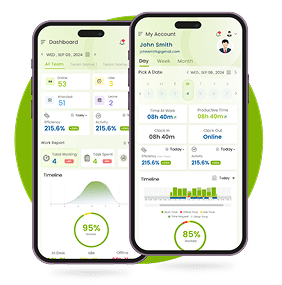AGILE VS. TRADITIONAL PROJECT MANAGEMENT
Your Team Isn’t a Factory Line; So Why Manage Like One?
Let’s play a quick game.
You’re knee-deep in a project. Deadlines are sliding. Tasks are overlapping like a messy Venn diagram. Your team is buzzing, but progress? Feels like a treadmill. Fast movement, zero distance.
So… you react.
You tighten the screws. More spreadsheets. More check-ins. More “urgent” syncs. You double down on control; because something has to give, right?
But here’s the real question:
Is It Your Team That’s Inefficient OR Is It The Way You’re Managing Them?
Traditional Project Management: Great for Blueprints, Terrible for Breakthroughs
On paper, traditional project management appears structured and reliable, predictable workflows, fixed timelines, and clearly defined tasks. It follows a linear progression: Plan → Execute → Deliver. Every milestone is accounted for, and every deadline meticulously scheduled, much like constructing a highway; precise, measured, and orderly.
But in practice, projects rarely unfold exactly as planned. Deadlines slip, stakeholder requirements shift, and the original roadmap often becomes outdated within weeks. Traditional project management is built on the assumption of stability, a useful approach in areas like construction or regulatory audits, where scope is clearly defined and change is minimal.
Yet when applied to projects that require exploration, adaptation, and ongoing input; such as those in product design, software development, or marketing campaigns, it often falls short. The focus shifts from outcomes to process, from learning to compliance. In trying to maintain control, teams lose the flexibility they need most and with it, the ability to respond effectively when circumstances evolve.
Agile: The Cool Kid with Commitment Issues?
Agile has become the go-to methodology for modern teams; fast, iterative, and team-driven. It thrives on feedback, embraces change, and empowers teams to self-organize. On the surface, it seems like the perfect fit for today’s evolving work environments.
But here’s what the glossy presentations often leave out: Agile without clear direction can quickly devolve into chaos. Without defined goals and boundaries, the flexibility that makes Agile so appealing can become a liability. Workflows shift frequently. Priorities are in flux. And despite the constant motion, meaningful progress can be hard to measure.
Daily stand-ups are common, but without structure, they often become routine status updates with little strategic value. Collaboration is emphasized, yet accountability may be unclear. Teams track velocity, but struggle to tie that momentum to outcomes. Visual boards are full of activity, but actual impact remains difficult to pinpoint.
So you ask: Did we go Agile or just… adrift?
It’s Not About Agile vs. Traditional. It’s About the Mess Between
Here’s the uncomfortable truth: This isn’t about frameworks.
It’s not about choosing the “right” methodology. It’s about visibility. Because what most teams lack isn’t discipline or creativity. It’s a clear line of sight, into who’s doing what, when, and whether the needle is actually moving.
Agile gets chaotic without oversight. Traditional gets sluggish without flexibility. What you need is alignment. A system that shows you work as it happens, not two weeks too late.
What Desklog Helps You Do (Without Burning Out Your Team)

Imagine managing projects with actual insight; not some paperwork.
Whether you’re a planner by nature or a pivot-master by necessity, Desklog gives you visibility without micromanagement, and structure without rigidity.
Here’s how:
Real-Time Project Tracking
Love Gantt charts? Prefer sprint boards? Either way, Desklog delivers.
Visual timelines; kanban view, real-time updates, and project maps, so you see exactly where things stand, without dragging your team into endless status meetings. It also enhances time efficiency through adaptive planning and time mapping that mirrors how your team actually works.
Clarity That Kills the “Where Are We?” Syndrome
No more chasing updates in Slack threads or drowning in email chains. With Desklog:
- Project status is always up-to-date
- Team workloads are transparent
- You know what’s done, what’s next, and what’s stuck
You’re not just watching progress, you’re leading it with actionable remote employee management insights and real-time metrics to measure employee productivity accurately.
Flexible Scheduling That Doesn’t Break People
Deadlines shouldn’t mean breakdowns.
Desklog lets you:
- View shift availability
- Plan work around leaves and off-days
- Avoid burnout-triggering overlaps
Desklog helps teams find work-life balance by integrating break & overtime notifications, optimizing shift planning, and managing employee absenteeism in the workplace before it becomes a recurring pattern.
It also ensures smoother workload distribution , so no one ends up overwhelmed while others are underutilized.
Visibility Without Micromanagement
With modern team time management features, Desklog promotes employee accountability without constant check-ins. Built-intime management tools, including automated time tracking, dashboards, and activity maps, reveal how time is spent and how it can be improved to increase productivity across the board.
This clarity is especially critical in remote employee management, where direct supervision isn’t always possible, but alignment still matters.
Agile? Traditional? Let’s Go With: Aligned
Instead of twisting your team to fit someone else’s framework…
Use a tool that adapts to how your team actually works.
So whether your project is a six-month blueprint or a two-week experiment, you lead it with clarity, not chaos. Desklog isn’t just about managing workflows, it’s about strengthening the pillars for effectively managing a team: transparency, accountability, and sustainable output.
Whether your project is a six-month blueprint or a two-week iteration, it aligns your work with what matters most; employee satisfaction, high performance, and consistent delivery. And when you’re equipped with smart dashboards, performance logs, and distraction tracking, you can finally combat what’s rarely discussed, workplace distractions that silently erode focus and reduce the rate of employee efficiency over time.
Billing & Admin? Desklog Handles It, So You Don’t Have To
Whether you bill hourly, per milestone, or by task; from automated timesheet generation to project billing budget tracking, and admin insights, you gain back valuable time and prevent manual errors that kill momentum. With built-in tools like a profit & loss calculator Desklog also gives you a clear view of financial performance across projects, so you’re not just managing work, but ensuring it’s profitable.
Ready to Work Smarter, Not Just “Harder”?

















